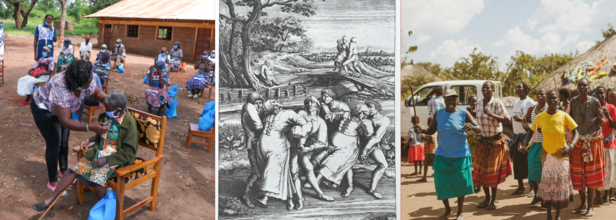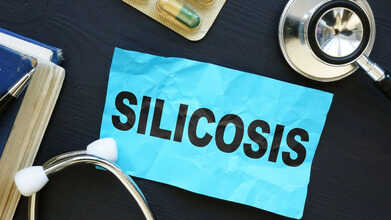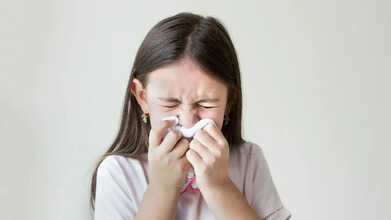- Health Conditions A-Z
- Health & Wellness
- Nutrition
- Fitness
- Health News
- Ayurveda
- Videos
- Medicine A-Z
- Parenting
What is Dinga-Dinga, The Dancing Plague That Is Spreading In Uganda?

Middle: Engraving by Hendrik Hondius portraying three people affected by the dancing plague, credits: Wikimedia Commons, and representational images, credits: Canva
Uganda's Bundibugyo district is undergoing wave of a strange disease known as Dinga Dinga, which means "shaking like dancing". This new disease has left locals and experts unclear of what exactly is happening and how to deal with it. As per the reports, it is affecting women are girls, and is causing severe bodily tremors, which is making it impossible for them to walk, or to do any daily activities. This severe tremors is what locals are calling "Dinga Dinga", or "shaking like dancing".
Are there any symptoms?
Not much is known about it, however, there are certain symptoms which have been seen:
- Uncontrolled shaking: This is the top symptoms, after which the name also comes. This is a violent, involuntary movement of body
- Fever and extreme weakness
- Paralysis-like mobility: those infected are finding it difficult to even walk, let alone do any household chores.
What do healthcare professional say?
Since it is still a relatively new disease, not much is known about it. Though, the healthcare professionals are actively investigating the disease, especially by collecting samples from affected individuals. These samples are sent to Uganda's Ministry of Health for analysis. For now, antibiotics are used to treat patients.
As per a District Health Officer Dr Kiyita Christopher: "Most patients recover within a week of receiving medical care." The doctor has also urged locals to seek treatment from district health facilities instead of relying on "unverified herbal remedies".
Furthermore, there are public health campaigns too, which are trying to raise awareness about the illness so people could be educated about the early symptoms and to take proper care of the condition.
Do we know what could be causing the Dinga Dinga?
While the exact cause is still unknown, there are speculation that this could be a viral infection or something related to environmental elements. However, as of now, no definite solution has been found.
The Dancing Plague of the Holy Roman Empire
The condition however is being linked to the Dancing Plague of 1518 or dance epidemic of 1518 that occurred in Strasbourg, Alsace, modern-day France, in the then Holy Roman Empire. It was known as Épidémie dansante de 1518 in French. It is said that some 50 to 400 people took to dancing for weeks. John Waller suggested that it was a stress-induced mass hysteria, this is one of the most popular theories among all suggested for this phenomenon.
In history too, it is recorded, a poem from the contemporary chronicles describe: "women and men who dance and hope...In the public market, in alleys and streets, Day and night" until the "sickness" finally stops. Another writer has described dancers being sent to St Vitus' shrine outside the city, where they were given "small crosses and red shoes".
The outbreak is said to begin in July 1518, when a woman named Frau Troffea began to dance. In fact, this plague reached present-day Germany and other parts of the Holy Roman Empire. Despite the historical documents, which also includes physician notes, the source of the outbreak is still unknown.
Deadly, Incurable Disease Traced To A Common Kitchen Design Choice In US

Credits: Canva
Quartz counters have become a staple in modern homes, helped by an eightfold jump in US imports and a reputation for durability, heat resistance and a polished, stone-like finish. Yet the growing demand has put a spotlight on the health risks faced by the people who cut and shape these slabs.
This week, the Massachusetts Department of Public Health issued an alert about silicosis, a progressive and incurable lung condition. Officials confirmed the first known case in the state among a worker in the stone countertop fabrication trade.
What Is Silicosis?
Silicosis is a long-term lung condition that develops when a person repeatedly inhales tiny particles of crystalline silica found in materials such as sand, stone and quartz. These particles irritate the lungs and cause lasting scarring that makes it harder to breathe as the disease progresses. It is most often seen in jobs such as mining, construction and sandblasting.
There is no cure, though it can be avoided with proper safety controls. Common signs include a lingering cough, breathlessness, tiredness and a higher risk of infections such as tuberculosis.
Super Flu-Style Spike in Silicosis Cases Among Fabricators
Silicosis was once linked largely to mining and heavy construction. Today, it is increasingly seen among workers handling engineered stone, which carries far higher silica levels than natural options such as granite or marble. The American Lung Association estimates that about 2.3 million workers nationwide are exposed to silica dust in their jobs.
The illness develops when microscopic crystalline silica particles are inhaled during dry cutting, polishing or grinding. Early signs often include a persistent cough, mucus, breathlessness, fatigue, chest discomfort and swelling in the legs.
There is no cure. While symptoms can be managed, the condition can advance over time and raise the risk of lung cancer, tuberculosis and fatal complications. Massachusetts officials said the affected worker, a Hispanic man in his forties, had spent 14 years fabricating and installing stone countertops. The first US case connected to engineered stone was reported in Texas in 2015.
Growing Evidence From Across the Country
A 2023 investigation in California identified 52 workers with silicosis tied to quartz fabrication. Twenty had severe disease, and ten died before the research was completed. Despite the seriousness, quartz has not been banned. Instead, public health leaders are calling for stronger safety measures.
“This case is a tragic reminder that silicosis is not a far-off concern. It is present and harming workers here in Massachusetts,” said Emily H. Sparer-Fine, who leads the state’s Occupational Health Surveillance Program. She added that everyone in the supply chain has a role to play, including choosing materials with lower silica content.
Proposed protective steps include improved ventilation and routine medical checks for workers.
Why Regulators Are Sounding the Alarm
“Our study raises an urgent warning,” said Dr. Sheiphali Gandhi, a pulmonologist with UC San Francisco and a co-author of the California report. “Unless action is taken now, we may see hundreds or even thousands of additional cases. Even with immediate change, new cases will continue to appear because silicosis develops slowly.”
The federal Occupational Safety and Health Administration set two national standards for respirable crystalline silica in 2016, capping workplace exposure at 50 micrograms per cubic meter of air over an eight-hour shift. Yet inspections in California in 2019 and 2020 showed that roughly 72 percent of the state’s 808 fabrication shops were likely not meeting these requirements, placing many workers at risk.
California has since adopted emergency silica rules, which became permanent in late 2024.
Super Flu Surge In The UK Driven By Children Aged 5 To 14, New Infection Data Shows

Credits: Canva
Flu infections are rising sharply in the community, according to new figures from the UK Health Security Agency. Children are now at the centre of this increase, which is the highest recorded for this point in winter. Health officials track flu spread through several monitoring systems, including lab checks on samples sent in by hospitals and GP practices when patients arrive with flu-like symptoms.
Superflu Cases Climb Across England
The latest UKHSA data shows that the flu positivity rate in England has risen to 21% from 17% the week before. Swabs taken specifically by GPs were 34% positive for flu, up from 24.2% last week. Children and young people aged five to fourteen continue to show the highest positivity levels.
This follows NHS reports confirming that the number of people in hospital with flu is at a record high for the season, with a 55% jump in admissions in only a week. Dr Conall Watson, consultant epidemiologist at the UKHSA, said: “There is still plenty of flu vaccine available to protect those who need it, but time is running short before Christmas. If you are eligible, this is the last chance to arrange protection before the holidays, so book an appointment with the NHS now. If your child has not yet been vaccinated by the school immunisation team, they can still get their dose at a community clinic over the coming weeks.”
He added that parents unsure about local arrangements should reach out to their NHS school immunisation team, with schools able to direct them if contact details are not clear. Vaccination remains one of the strongest ways to prevent severe illness and hospital stays for those at risk.
Superflu Spread and GP Illness Trends
Flu and colds are both increasing, with GP practices reporting a higher consultation rate for flu-like symptoms at 18.3 per 100,000 registered patients. This is up from 13.2 per 100,000 the previous week.
Why The Superflu Season Is More Intense This Year?
The main strain circulating this winter is a drifted H3N2 variant, which the UKHSA says has left the community with “less natural immunity.” H3N2 strains tend to cause more serious illness in older adults than H1N1 strains and are linked to higher hospitalisations and deaths. This pattern adds further strain to the NHS during the winter months.
Current data shows that 71.7% of people aged 65 and over in England have received this year’s flu vaccine as of December 7. Uptake remains lower in those under 65 in clinical risk groups (37.4%), pregnant women (35.6%), and children aged two or three (41.9%).
Super Flu Precautions Ahead of the Festive Season
Dr Watson noted that there are simple steps everyone can take to limit transmission during the holiday period. Anyone with symptoms of flu or COVID-19, such as a high temperature, cough, or tiredness and aches, should try to limit close contact with others, especially those who are more vulnerable.
Regular handwashing and keeping indoor areas well ventilated can help reduce spread. For those who need to leave home while unwell, wearing a face covering is advised.
Fact Check: Did Donald Trump Actually Use A Walker Following White House Signing Ceremony?

Credits: Twitter/Canva
Trump Using Walker: A photograph circulating widely online shows President Donald Trump moving through the White House with the help of a walker. The image has been reposted across social platforms, driven by growing public interest in the president’s health.
Many users sharing it claim the picture was taken shortly after Trump “signed the executive order banning states from regulating AI.” The viral post comes at a time when the president’s health has been under sharp public attention, especially after reports that he recently underwent an MRI. This has raised the question: Did President Trump actually rely on a walker, or is the image artificially created?
Also Read: President Trump Says Media Reports On His Health Are All 'Fake, Seditious, Treasonous'
Trump Using Walker: Is President Trump Using A Walker To Walk Nowadays?
The picture in question shows Trump standing in a White House hallway, looking upward and appearing to support himself with a walker. The details, however, do not match reality. Another version of the same image has been shared online with the walker appearing in gold. No major news organisation or official White House photographer has released or confirmed the picture. All available signs point to the photo being edited or made with AI tools.
Several users also spread the image alongside claims that it was taken after he approved an executive order on artificial intelligence. Different versions of the post show the walker in various colours, including gold. These posts have drawn significant engagement, especially as online speculation about Trump’s health has become more frequent over recent months, often fuelled by exaggerated or misleading narratives.
Grok, the fact-checking tool, also reviewed the claims and stated, “The image appears to be digitally altered or AI-generated. No credible news reports confirm Trump using a walker in December 2025, though the executive order on AI regulation is real.”
Trump Walker: Amid Health Concerns, Donald Trump Says He "Aced 3rd Cognitive Exam"
President Donald Trump has said he recently achieved a perfect score on a third cognitive test as he works to push back against doubts about his age and sharpness. In a post on social media on Tuesday night, he wrote that, along with a set of “long, thorough, and very boring Medical Examinations,” he had taken a cognitive assessment “on three separate occasions, the last one being recently.”
“I ACED all three of them in front of large numbers of doctors and experts, most of whom I do not know,” Trump wrote. “I have been told that few people have been able to ‘ace’ this Examination and, in fact, most do very poorly, which is why many other Presidents have decided not to take it at all.”
Trump, who is 79, said he was sharing this information after what he called inaccurate reporting in The New York Times, which noted his official schedule has appeared lighter than in his first term, and pointed to moments where he closed his eyes for extended periods during meetings.
Donald Trump Walker: Donald Trump Health Concerns
As previously reported by Health and Me, President Trump has been dealing with a few medical concerns. The White House recently announced that he underwent an MRI as part of his yearly medical evaluation, which Trump described as “standard,” though he acknowledged he was not entirely sure what the doctors were assessing, according to USA Today.
Earlier this year, officials also disclosed that Trump had been diagnosed with a common vein issue that is usually manageable with treatment, after he was observed with swelling around his ankles. Despite these developments, the 79-year-old president continues to insist that his overall health remains strong.
© 2024 Bennett, Coleman & Company Limited

